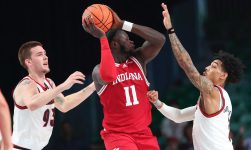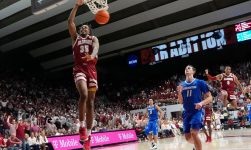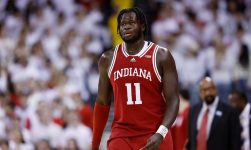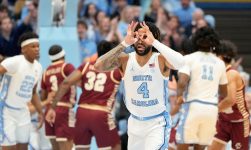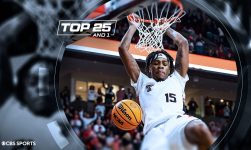A new era of college athletics is upon us, and leaders do not have much time to prepare for the transformative age.
College sports is on the precipice of changing forever as leaders from the NCAA and several power-conference levels have agreed to destroy the amateurism model and share revenue with players by coming to terms on settling a multi-billion dollar lawsuit that threatened to bankrupt the collegiate athletics enterprise.
The NCAA Board of Governors voting Wednesday to accept the anti-trust lawsuit settlements and move forward was a pivotal rubber-stamping. The SEC and Pac-12 are set to vote Thursday before it’s in the plaintiff lawyers’ hands; they each are expected to approve moving forward with settling in separate meetings.
The $2.8 billion settlement in the House v. NCAA case, a landmark legal battle, has far-reaching implications anchored by revenue sharing and the expansion of roster sizes, which might also spark more legal battles with Title IX implications. In the immediate future, the legal settlement is transformative for players because not only will past athletes be compensated for prior restrictions on earning from their name, image, and likeness via the $2.8 billion settlement, but the agreement sets the stage for a future revenue-sharing model, a first in the NCAA’s long history, benefiting thousands of collegiate athletes starting as soon as Fall 2025.
The NCAA and its conferences will hammer out the details of new revenue-sharing and governance models over the next few months, but a framework was revealed in internal documents uncovered by multiple outlets in recent weeks. Athletic departments must now prepare for new line items that could balloon up to $30 million annually as the richest schools prepare to share upwards of $22 million in revenue with players while expanding roster sizes with unlimited scholarships, according to those documents.
The NCAA agreed to pay the past damages over the next 10 years ($277 million annually) and will fund the payments by cutting into its revenue shares with Division I schools. Had the case gone to trial in January 2025, the NCAA and its power conferences risked being on the hook for more than $4.2 billion because of a triple multiplier tied to antitrust law. Even worse, had a settlement not been reached, the parties risked $20 billion in back damages tied to several antitrust lawsuits that could have forced them into bankruptcy, according to documents circulated last week among conference presidents.
“The most important part about the settlement — and let’s face it, there’s still a lot of work to be done there — is it creates some clarity and some visibility on a whole bunch of issues that have sort of been roiling everybody for a while,” NCAA president Charlie Baker said last week. “The other thing it does is create predictability and stability for schools. It creates a tremendous opportunity for student-athletes.”
Discussions concerning a settlement structure have been ongoing for nearly a year. The NCAA is responsible for 40% of the $2.8 billion settlement, and the remaining 60% will come from reducing its revenue distributions to the 32 Division I conferences over the next 10 years ($1.6 billion). The NCAA is utilizing a formula based on revenue distribution presented to each league over a nine-year period starting in 2016, which leans heavily on basketball units tied to NCAA Tournament participation, according to Yahoo Sports. The Power Five conferences – ACC, Big Ten, Big 12, Pac-12 and SEC – will pay 24% of the overall damages, followed by the Group of Five at 10%.The FCS is on the hook for 14% and non-football conferences in Division I will pay 12% of the overall agreement, according to documents reviewed by CBS Sports.
The commissioners of the 22 non-FBS conferences made a late push Monday to flip the financial structure so that the Power Five conferences would be responsible for 60% of the withheld NCAA distributions over the next 10 years, but that effort failed in the 11th hour when the NCAA’s Board of Directors approved the aforementioned settlement terms that evening. The 27 conferences outside the current Power Four leagues will be on the hook for 60% of the NCAA’s withheld distributions.
Beyond the monetary figures and future revenue sharing, the settlement also further widens the gap between the four power conferences fueled by football revenue and the Group of Five conferences in the Football Bowl Subdivision. Power conferences are also expected to design a new governance structure to enforce rules that will be separate from its compatriots. The legislation is expected to provide unlimited scholarships while restructuring roster limits, which could cut down on the number of active football players but also allow programs to award more scholarships for sports like baseball, which has long been stuck on 11.7 scholarships to share with a team of nearly 40 players.
Further complicating the relationships among conferences is the financial gap exacerbated by a recently approved revenue structure with the College Football Playoff, which shares most of its revenue with the Big Ten and SEC.
Simply put, just because the biggest lawsuit in NCAA history is settled and players will soon be paid after years of carrying a multi-billion dollar industry on their backs, that doesn’t mean the future will be without monumental challenges that could lead to the elimination of sports and further separation between the haves and have-nots among athletic departments in the FBS.
How much will current and future players be paid?
The schools among the Power Four conferences are expected to pay current players roughly $20 million annually as part of a new revenue-sharing program. The figure will fluctuate from school to school, reflecting an estimated share of 22% of annual revenue generated by Power Four schools.
The agreement is expected to include a cap on revenue-sharing, which could start as high as $22 million annually per school, according to Yahoo Sports.
“Local decisions, I think, are good at times where schools that have more resources can do more,” ACC commissioner Jim Phillips said last week. “… So some flexibility in a final decision and a final agreement will be helpful for our schools.”
Former Pac-12 schools are included in the suit as part of the pay for past damages. According to multiple reports, the five power conferences are responsible for roughly 40% of the NCAA’s school reductions for damages (between $597.6 million to $730.4 million). Those schools are expected to see an average drop between $1 million and $2 million in annual revenue from the NCAA to fund the settlement.
Group of Five schools are responsible for 17% ($255.6 million to $312.4 million) and Football Championship Subdivision conferences will share 22% of the reductions ($327.6 million to $400.4 million).
Meanwhile, the NCAA is expected to reduce operating costs by $18 million a year, dipping into reserves and insurance to help fund its portion of the legal settlement ($1.1 billion), according to Yahoo Sports.
Will the math work in the Group of Five?
Many industry leaders, particularly those in the Group of Five conferences, are concerned revenue-sharing could send more athletic department budgets into the red, leading to the elimination of sports programs entirely. Many athletic departments are subsidized by student fees from the university and state funds, and some already operate at a deficit.
More than 50% of Group of Five schools earn less than $40 million annually in revenue. The Power Five conferences (then including the Pac-12) combined for more than $3.3 billion in revenue for the 2022 fiscal year, according to federal tax records. Ohio State earned $251.6 million in revenue last year to lead all Power Five schools.
“You really have to think about [Power Four] as different,” House plaintiff attorney Jeffrey Kessler said during a panel at Howard University in April, according to Yahoo Sports. “The reason we get tied in knots is because we conflate those schools who have developed these gigantic independent commercial businesses with the schools who are still just educational institutions with extracurricular activities. When you try to come up with one rule for all, you go crazy. You have to look at the schools differently. For the ones with the money, there is plenty of money to compensate the athletes and share it with the women’s sports.”
Title IX and antitrust questions remain
Plaintiffs in the House suit are expected to give up their right to file antitrust lawsuits against the NCAA’s rules for 10 years, and the plaintiff attorneys are expected to drop two additional pending antitrust cases against the NCAA. This agreement could be strengthened if the NCAA is finally successful in lobbying Congress, which could codify the settlement with legislation protecting the NCAA and its members with an antitrust exemption. Congress, however, has been slow to act after being presented with more than a dozen proposals concerning NIL guardrails over the last several years.
Title IX also complicates matters, and future court battles could loom. The unspoken truth among administrators is it seems unlikely they will advocate for equal pay for athletes whose sports earn less than football and men’s basketball.
“It’s very likely we’re going to see non-revenue sports get massacred,” said Jason Belzer, president of Student Athlete NIL. “Title IX is going to be a very big battle. How are you going to stop it? It’s going to be tough.”
Many finer details are yet to be finalized. Attorneys will soon draft the terms of the settlement agreement, which they will then present to Senior District Judge Claudia Wilken in California’s Northern District at a preliminary hearing yet to be scheduled.
Roster sizes and scholarship limits will change
The new model will likely lift scholarship limits but also limit roster sizes. Those details are expected to be finalized in the coming months at the conference level and could vary within Division I.
Theoretically, football roster sizes could be trimmed from 120 to 100 players, but scholarships could be provided to all players instead of the currently mandated 85. For baseball-crazy conferences like those in the power structure, programs could finally provide scholarships to every player on the roster rather than often-criticized equivalencies of 11.7 scholarships that are shared among 27 players on a 39-man roster.
Again, there is much to consider and discuss before numbers are finalized on the conference level over the next year.
What happens to NIL collectives?
The NCAA has also proposed a new enforcement infrastructure to target pay-for-play and booster-led NIL collectives, though the details remain vague, according to documents obtained last week by Yahoo Sports.
The documents contend the court will reaffirm rules around compensation, “including the prohibition on booster payments if they are not true NIL.” Schools will also be provided “economic incentives” to house NIL collectives within the university.
“Collectives aren’t going to go away if there’s a salary cap,” said Russell White, president of The Collective Association. “Universities will continue to want to compete above and beyond (the base revenue shares).”
Ten-year NCAA revenue reduction projections
FBS Power Five: $597.6 million to $730.4 millionFBS Group of Five: $255.6 million to $312.4 millionFCS: $327.6 million to $400.4 millionBig Ten: $149 million to $182.6 millionACC: $141.3 million to $172.7 millionSEC: $111.6 million to $136.4 millionBig 12: $99 million to $121 millionPac-12: $96.3 million to $117.7 million

